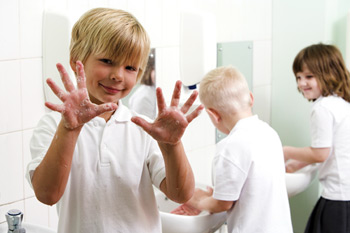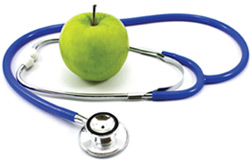Back-to-School Health Basics
 It’s back-to-school time again. That means shopping for new clothes and school supplies and getting used to homework and early mornings. Unfortunately, it also means your child is more likely to get sick.
It’s back-to-school time again. That means shopping for new clothes and school supplies and getting used to homework and early mornings. Unfortunately, it also means your child is more likely to get sick.
Contrary to the lingering misconception that people catch colds because they get chilled when the temperature drops — a notion that has a bit of credence because some viruses do tend to replicate better when it’s colder outside — kids tend to get sick more often when school starts because they are exposed to so many other children in an enclosed school building.
“It’s the herd phenomena,” says Dr. Mary Chris Bailey, chief of pediatric emergency medicine at Newton-Wellesley Hospital. All you need is one child to bring a virus to school, and the germs will spread.
Dr. Vana Melkonian, a physician with Pediatric Associates of Wellesley, confirms this: “Our busiest season is between November and April.”
So what sicknesses is your child likely to pick up? Bailey says that typically they see mostly upper respiratory infections between September and February and mostly gastrointestinal infections between December and March. Both of these illnesses are caused by viruses.
Interestingly, Bailey notes, one of the most common things that lands kids in the emergency room during the first few weeks after school starts are sports injuries. Children are not as active in team sports during the summer, and they haven’t conditioned their bodies to be ready for them. It’s so predicable that they’ll see sports injuries soon after school starts that, “I can set my clock to it,” claims Bailey. She says parents can minimize these injuries by making sure their children take the time to get back into shape before they hit the playing fields.
There also are steps parents can take to make sure their children are less vulnerable to viruses, which spread from one person to another through droplets from a sneeze or cough of an infected person. The most important thing, as stressed by health care professionals, is proper hand washing. As Anne Prinn, head of school nurses for Wellesley Public Schools, emphasizes, “Hand washing, hand washing, hand washing: I’d like to say something more scientific, but if you want your child to stay healthy, it’s as simple as that.”
Experts recommend that children wash their hands with soap and warm water for at least as long as it takes them to sing their ABCs or the “Happy Birthday” song. Another option is to use hand sanitizers. Keeping a small bottle in a student’s desk can be helpful. A child should wash his or her hands before eating and after using the toilet, blowing his or her nose, or playing outside. While it’s clearly an important step to staying healthy, hand washing can be difficult for young children. So try to teach children the hand washing basics before they start school.
 Other steps to stay healthy include:
Other steps to stay healthy include:
- Stay up-to-date on immunizations. This is crucial for making sure your child does not get more serious illnesses.
- More specifically, have children get the flu vaccine, which now also includes prevention from the H1N1 virus, or Swine Flu. This vaccine is not mandatory but was strongly recommended by the health care professionals we spoke to.
- Make sure your children get enough sleep on a consistent basis. This is in contrast to a summer sleep schedule when children tend to stay up later. Dr. Tim Murphy from Weston Primary Care says you should encourage your children to get up earlier a few weeks before school starts so they are used to the fall schedule. Patty Wright, school nurse leader for the Weston Public Schools, says that children who are ages five to twelve should get between ten and eleven hours of sleep each night, and older children still should get between nine and ten hours of sleep.
- Focus on a healthy diet. Specifically, start each day with a good breakfast.
- Get an annual physical to make sure your pediatrician is on top of any conditions your child might have. Checkups let the pediatrician evaluate your child’s growth and development, perform tests, and give vaccines.
- Teach children to cover their mouths or noses when they cough or sneeze. Encourage them to cough or sneeze into a tissue or into the crook of their elbows.
- Tell children to try to keep hands — which often have germs —away from their eyes and mouths.
- Don’t let children share water bottles, food, or other personal items. Follow the simple rule: if you put it in your mouth, you shouldn’t share it.
- Avoid sick classmates.
Another thing that the experts agree on is that is that it’s a great idea for parents to keep an open communication channel between teachers, school nurses, and pediatricians. As Wright of Weston stresses, “Communication is huge. Call or e-mail your school nurse and give her a heads up if your child has any medical issues or is going to have dental work or surgery. The more the nurse knows the better. We’re here to make sure your child is healthy and is doing his or her job, which is learning in school,” she says.
Lastly, keep your children out of school when they are sick. Following this common courtesy benefits everyone in the long run.
So how do you know if your child is too sick to go to school? Again, Wright suggests that if you are on the fence, you should pick up the phone and call the school nurse because he or she knows what’s going around school. The same holds true with your pediatrician. Give the office a call if you have any questions.
According to the Web site Web MD, the first thing you should consider is if the child has a fever. “If there’s no fever, it’s probably just a cold,” the site notes. However, if your child has a fever of over 100.4 degrees, he or she should stay home. Some other situations in which Web MD suggests keeping your child at home or seeing a doctor are:
- Bad cough or cold symptoms. It could be a severe cold or even bronchitis, flu, or pneumonia.
- Sore throat. A severe sore throat could be a symptom of strep throat even if there is not a fever.
- Diarrhea or vomiting.
- Earache.
- Pink Eye (Conjunctivitis). Keep your child home until the doctor has given permission to go back to school.
- Rash.
In general, your children can return to school when they are fever- or symptom-free for 24 hours, without medicine.
Navigating your way through back-to-school illnesses can be easier than you thought if you just follow some basic rules. Now, if homework were only so simple. ![]()
© 2011 Elm Bank Media | Beth Furman, Publisher | Beth@ElmBankMedia.com


recent comments